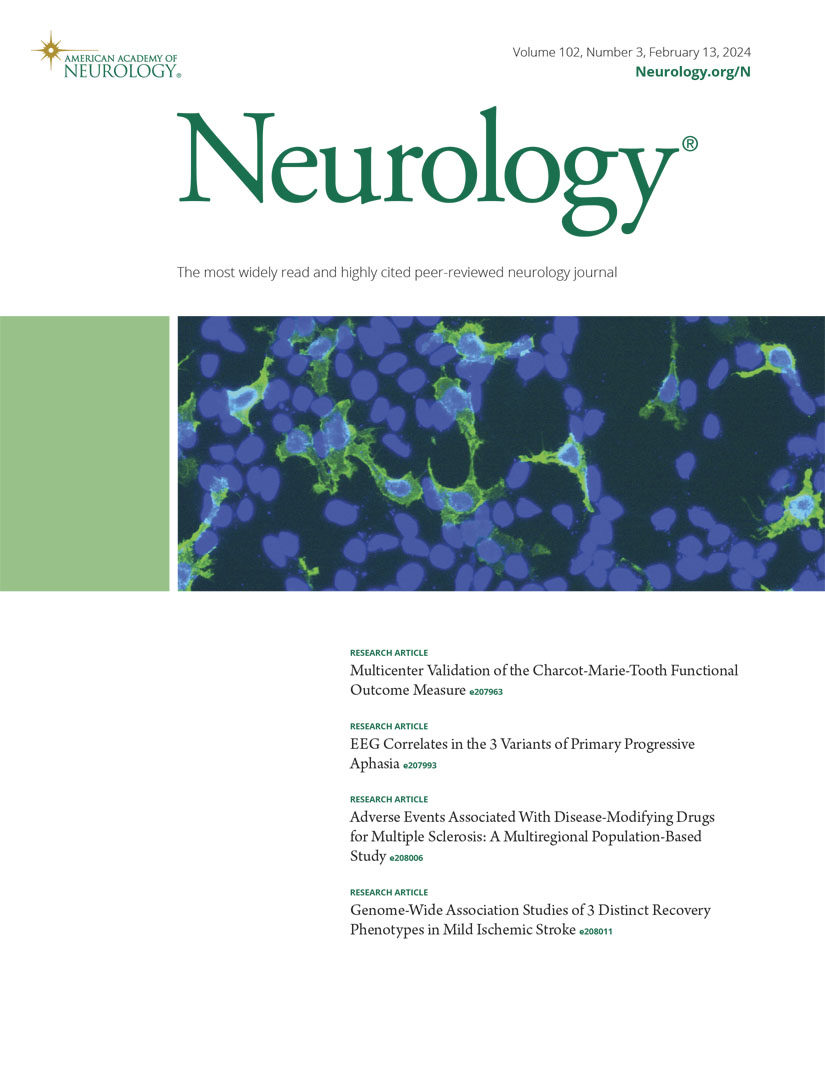CGRP-Targeted Migraine Therapies in Patients With Vascular Risk Factors or Stroke: A Review.
IF 7.7
1区 医学
Q1 CLINICAL NEUROLOGY
引用次数: 0
Abstract
Calcitonin gene-related peptide (CGRP)-targeted therapies, including monoclonal antibodies (mAbs) and gepants, represent a major advancement in migraine prevention, offering greater efficacy and improved tolerability compared with traditional treatments. These agents selectively inhibit the CGRP pathway, a key mediator in migraine pathophysiology, and are increasingly used even as first-line options in selected patients. While clinical trials and real-world data suggest a favorable cardiovascular (CV) safety profile, particularly in patients without major risk factors, evidence remains limited for those with established vascular disease or recent vascular events. Concerns persist regarding long-term effects and the safety of CGRP blockade in high-risk populations. This narrative review focuses on the CV and cerebrovascular safety of CGRP-targeted migraine treatments-an area of growing clinical relevance. We compare these newer agents with traditional migraine preventives and highlight the paucity of data in patients with previous stroke, subarachnoid hemorrhage, myocardial infarction, or significant CV comorbidities. In addition, we discuss the emerging topic of dual CGRP pathway blockade (mAbs plus gepants), which has not previously been reviewed in the context of vascular risk. Based on currently available scientific evidence, we offer structured clinical considerations to guide the use of CGRP-targeted therapies in patients with vascular risk or cerebrovascular disease. Our aim is to support informed decision making in a population that has often been excluded from clinical trials but is becoming increasingly important in clinical practice.有血管危险因素或卒中患者的cgrp靶向偏头痛治疗:综述
降钙素基因相关肽(CGRP)靶向治疗,包括单克隆抗体(mab)和gepants,代表了偏头痛预防的重大进展,与传统治疗相比,具有更高的疗效和更好的耐受性。这些药物选择性地抑制CGRP通路,这是偏头痛病理生理的关键介质,并且越来越多地被用作选定患者的一线选择。虽然临床试验和实际数据表明心血管(CV)的安全性良好,特别是在没有主要危险因素的患者中,但对于已确诊的血管疾病或近期发生血管事件的患者,证据仍然有限。对CGRP阻断在高危人群中的长期影响和安全性的担忧仍然存在。这篇叙述性综述的重点是cgrp靶向偏头痛治疗的心血管和脑血管安全性,这是一个越来越重要的临床相关性领域。我们将这些新药与传统的偏头痛预防药物进行比较,并强调既往卒中、蛛网膜下腔出血、心肌梗死或显著心血管合并症患者的数据缺乏。此外,我们还讨论了双CGRP通路阻断(mab + gepants)这一新兴话题,这在血管风险背景下尚未被审查。基于现有的科学证据,我们提供结构化的临床考虑,以指导血管危险或脑血管疾病患者使用cgrp靶向治疗。我们的目标是支持经常被排除在临床试验之外但在临床实践中变得越来越重要的人群的知情决策。
本文章由计算机程序翻译,如有差异,请以英文原文为准。
求助全文
约1分钟内获得全文
求助全文
来源期刊

Neurology
医学-临床神经学
CiteScore
12.20
自引率
4.00%
发文量
1973
审稿时长
2-3 weeks
期刊介绍:
Neurology, the official journal of the American Academy of Neurology, aspires to be the premier peer-reviewed journal for clinical neurology research. Its mission is to publish exceptional peer-reviewed original research articles, editorials, and reviews to improve patient care, education, clinical research, and professionalism in neurology.
As the leading clinical neurology journal worldwide, Neurology targets physicians specializing in nervous system diseases and conditions. It aims to advance the field by presenting new basic and clinical research that influences neurological practice. The journal is a leading source of cutting-edge, peer-reviewed information for the neurology community worldwide. Editorial content includes Research, Clinical/Scientific Notes, Views, Historical Neurology, NeuroImages, Humanities, Letters, and position papers from the American Academy of Neurology. The online version is considered the definitive version, encompassing all available content.
Neurology is indexed in prestigious databases such as MEDLINE/PubMed, Embase, Scopus, Biological Abstracts®, PsycINFO®, Current Contents®, Web of Science®, CrossRef, and Google Scholar.
 求助内容:
求助内容: 应助结果提醒方式:
应助结果提醒方式:


